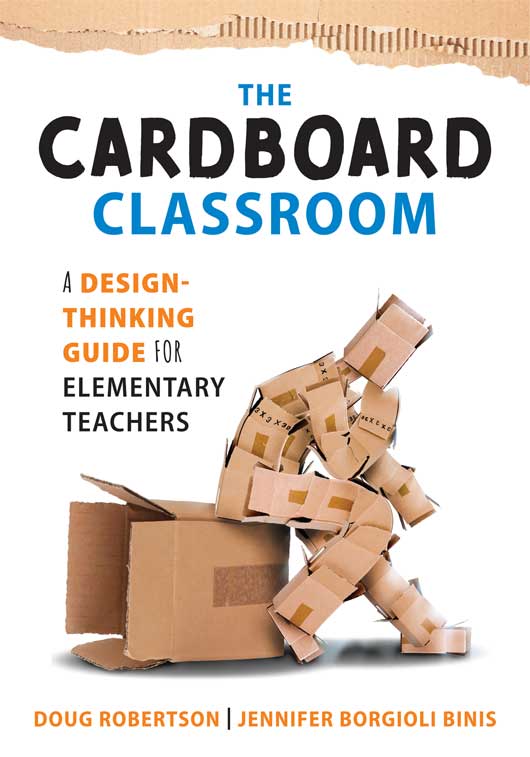Free Reproducibles
Cardboard Classroom
A Design-Thinking Guide for Elementary Teachers
How can elementary educators create a learning environment that is conducive to creativity, critical thinking, and student ownership of learning? By implementing design-minded real life examples in the classroom. All while achieving positive student learning outcomes.
Benefits
- Discover why design thinking is more the identity of the teacher than instructional strategy
- Learn how design-minded teaching advances student learning and improves engagement
- Study real-world examples and experiences of the design process in action
- Receive comprehensive examples of projects you can utilize and adapt to fit your classroom’s needs
- Obtain reproducible tools and templates to enhance your understanding of the material
TABLE OF CONTENTS
Introduction: Lightning and Thunder
Chapter 1: But Seriously, What Does Design Minded Mean? An Overview of Design-Minded Teaching
Part 1: Putting Design-Minded Teaching Into Practice
Chapter 2: Define: What’s the Problem? What’s the Goal?
Chapter 3: Design: How Can We Solve the Problem?
Chapter 4: Build: How Do We Create a Solution?
Chapter 5: Test and Revise: What Happens When We Try Out the Solution and Respond to Data?
Chapter 6: Reflect: What Did We Learn?
Chapter 7: Put It Into Practice
Part 2: Becoming a Design-Minded Teacher
Chapter 8: Specific Designs
Chapter 9: Assessment in the Design-Minded Classroom
Chapter 10: Cure-Alls, Buy-In, and Trust
PRINTABLE REPRODUCIBLES
Chapter 1
- Figure 1.1: Define Your Teacher Identity
- Figure 1.2: Your Design Experiences as a Student
- Figure 1.3: Times You Led Students in a Design Experience
Chapter 2
Chapter 3
Chapter 4
- Figure 4.1: Habits and Behaviors of Members of a Learning Community
- Figure 4.2: Build Phase Class Rules
- Build Reflection Template: How Do We Create a Solution?
Chapter 5
- Figure 5.1: The Test and Revise Cycle
- Test and Revise Reflection Template: What Happens When We Try Out the Solution and Respond to Data?
Chapter 6
- Figure 6.4: General Guiding Questions for After A Test
- Reflect Reflection Template: What Did We Learn?
Chapter 7
- Figure 7.2: Guide to Build a Trap for a Tree Kangaroo
- Put It Into Practice Reflection Template
- Post Assessment
Chapter 8
- Figure 8.1: Blank Planning Document
- Figure 8.3: Guide to Build Wind-Powered Cars
- Figure 8.5: Guide to Build Trebuchets
- Figure 8.7: Guide to Build a Cardboard Arcade
- Figure 8.9: Guide to Build Stop-Motion Movies
- Figure 8.11: Guide to Build a Cardboard City
- Figure 8.13: Guide to Build a Rube Goldberg Machine
- Figure 8.15: Guide to Build Marionettes
Chapter 9
- Figure 9.1: Academic Honesty Rubric to Assess Potential Plagiarism
- Figure 9.2: Guide to Building a Collaborative Rubric
SUGGESTED RESOURCES
BOOKS
- Fisher, D., & Frey, N. (2015). Unstoppable learning: Seven essential elements to unleash student potential. Bloomington, IN: Solution Tree Press.
- Kaiser, A. (2020). Designing the future: How engineering builds creative critical thinkers in the classroom. Bloomington, IN: Solution Tree Press.
- Marzano, R. J., & Marzano, J. S. (2015). Managing the inner world of teaching: Emotions, interpretations, and actions. Bloomington, IN: Marzano Resources.
- Parrish, N. (2022). The independent learner: Metacognitive exercises to help K–12 students focus, self-regulate, and persevere. Bloomington, IN: Solution Tree Press.
- Wiliam, D. (2011). Embedded formative assessment. Bloomington, IN: Solution Tree Press.
- Wiliam, D. (2018). Embedded formative assessment (2nd ed.). Bloomington, IN: Solution Tree Press.
WEBSITES

